Real Estate Equities: Buy Back and Capital Raising Scenarios
VerifiedAdded on 2023/01/05
|14
|3662
|88
AI Summary
This document discusses the scenarios of buy back and capital raising in real estate equities. It explores the reasons behind buy backs, potential traps and manipulations, and provides real examples of stock buy backs. The document also explains the impact of buy backs on investor confidence and market valuation.
Contribute Materials
Your contribution can guide someone’s learning journey. Share your
documents today.

1
Name:
Course
Professor’s name
University name
City, State
Date of submission
Name:
Course
Professor’s name
University name
City, State
Date of submission
Secure Best Marks with AI Grader
Need help grading? Try our AI Grader for instant feedback on your assignments.
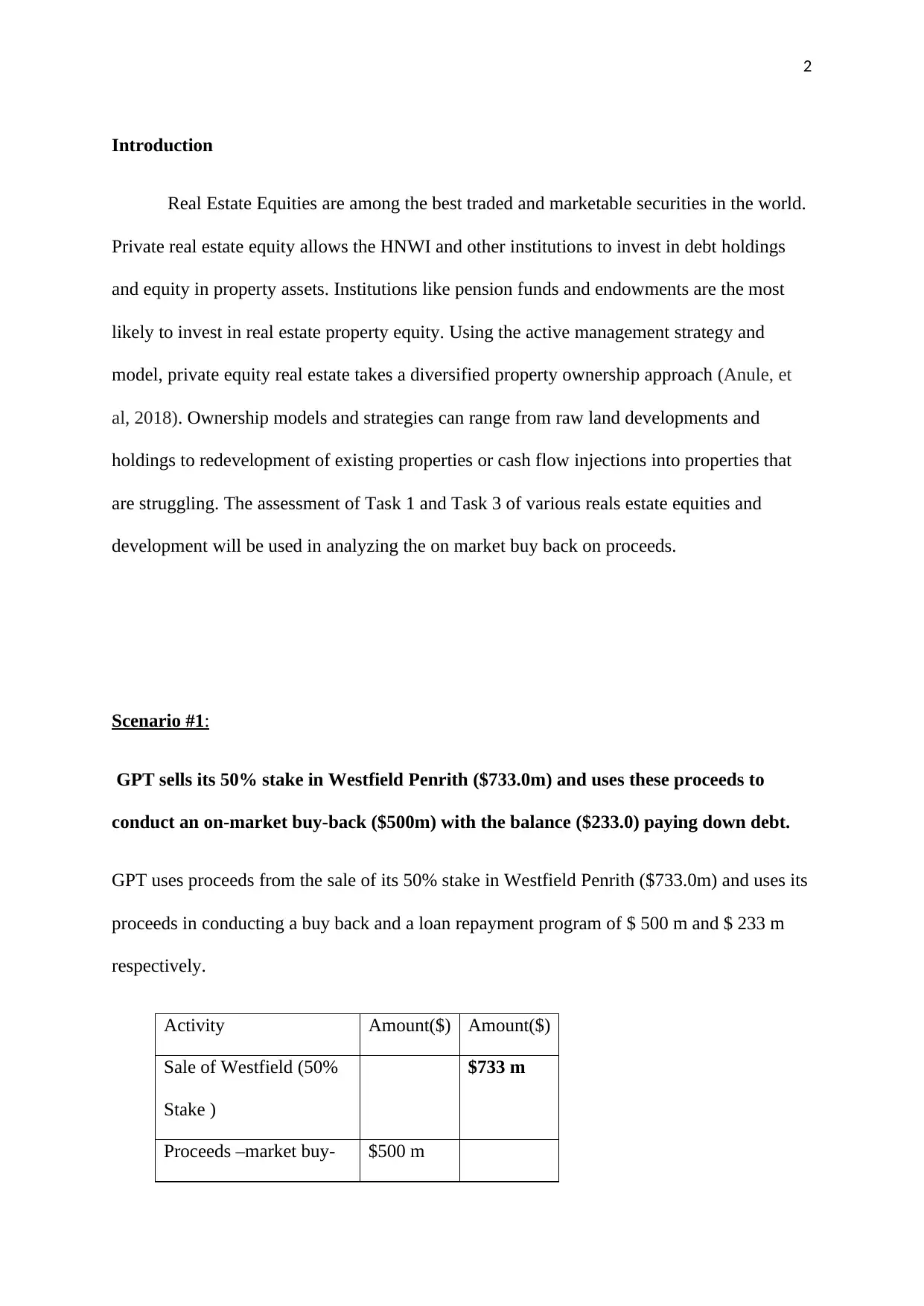
2
Introduction
Real Estate Equities are among the best traded and marketable securities in the world.
Private real estate equity allows the HNWI and other institutions to invest in debt holdings
and equity in property assets. Institutions like pension funds and endowments are the most
likely to invest in real estate property equity. Using the active management strategy and
model, private equity real estate takes a diversified property ownership approach (Anule, et
al, 2018). Ownership models and strategies can range from raw land developments and
holdings to redevelopment of existing properties or cash flow injections into properties that
are struggling. The assessment of Task 1 and Task 3 of various reals estate equities and
development will be used in analyzing the on market buy back on proceeds.
Scenario #1:
GPT sells its 50% stake in Westfield Penrith ($733.0m) and uses these proceeds to
conduct an on-market buy-back ($500m) with the balance ($233.0) paying down debt.
GPT uses proceeds from the sale of its 50% stake in Westfield Penrith ($733.0m) and uses its
proceeds in conducting a buy back and a loan repayment program of $ 500 m and $ 233 m
respectively.
Activity Amount($) Amount($)
Sale of Westfield (50%
Stake )
$733 m
Proceeds –market buy- $500 m
Introduction
Real Estate Equities are among the best traded and marketable securities in the world.
Private real estate equity allows the HNWI and other institutions to invest in debt holdings
and equity in property assets. Institutions like pension funds and endowments are the most
likely to invest in real estate property equity. Using the active management strategy and
model, private equity real estate takes a diversified property ownership approach (Anule, et
al, 2018). Ownership models and strategies can range from raw land developments and
holdings to redevelopment of existing properties or cash flow injections into properties that
are struggling. The assessment of Task 1 and Task 3 of various reals estate equities and
development will be used in analyzing the on market buy back on proceeds.
Scenario #1:
GPT sells its 50% stake in Westfield Penrith ($733.0m) and uses these proceeds to
conduct an on-market buy-back ($500m) with the balance ($233.0) paying down debt.
GPT uses proceeds from the sale of its 50% stake in Westfield Penrith ($733.0m) and uses its
proceeds in conducting a buy back and a loan repayment program of $ 500 m and $ 233 m
respectively.
Activity Amount($) Amount($)
Sale of Westfield (50%
Stake )
$733 m
Proceeds –market buy- $500 m
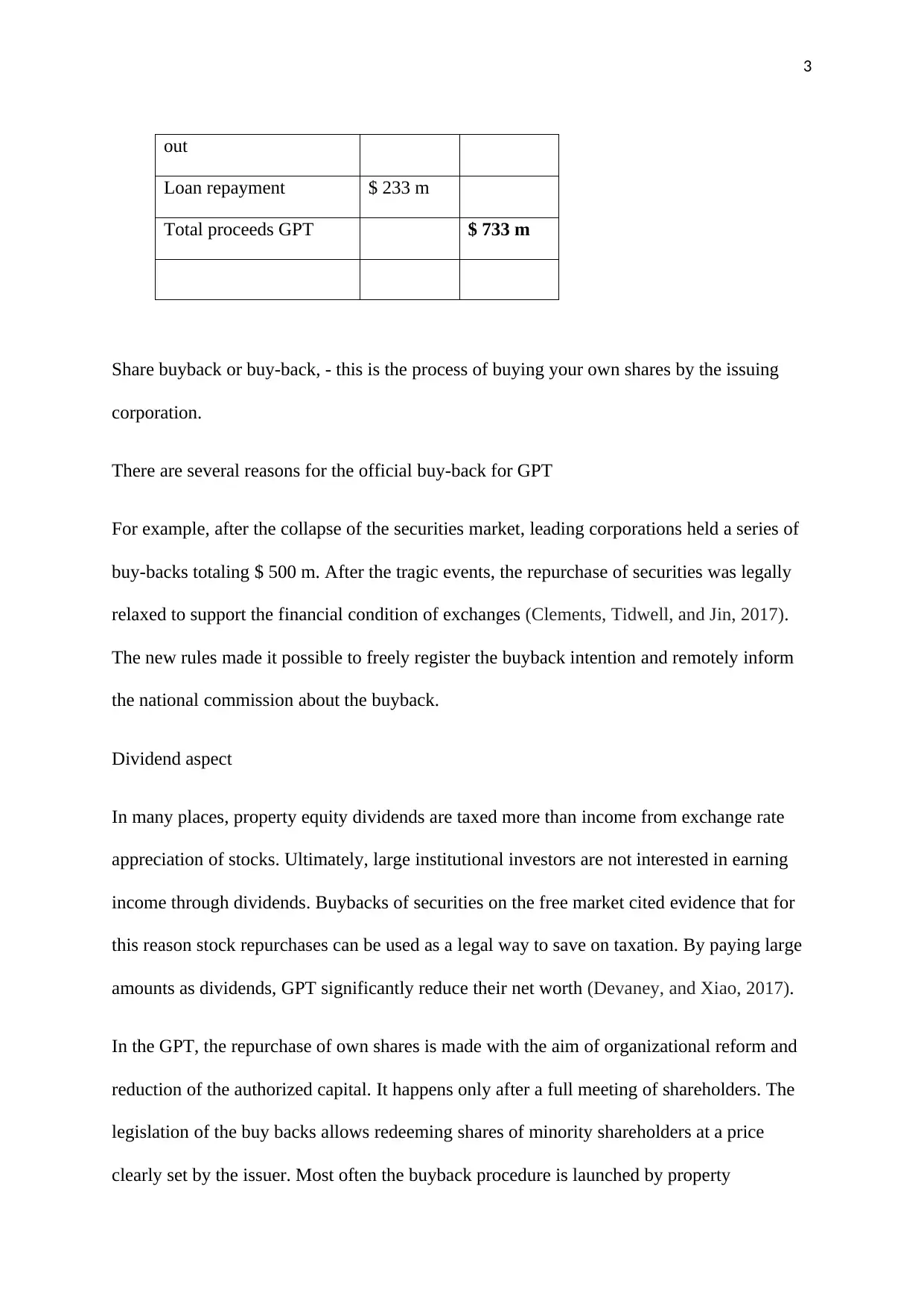
3
out
Loan repayment $ 233 m
Total proceeds GPT $ 733 m
Share buyback or buy-back, - this is the process of buying your own shares by the issuing
corporation.
There are several reasons for the official buy-back for GPT
For example, after the collapse of the securities market, leading corporations held a series of
buy-backs totaling $ 500 m. After the tragic events, the repurchase of securities was legally
relaxed to support the financial condition of exchanges (Clements, Tidwell, and Jin, 2017).
The new rules made it possible to freely register the buyback intention and remotely inform
the national commission about the buyback.
Dividend aspect
In many places, property equity dividends are taxed more than income from exchange rate
appreciation of stocks. Ultimately, large institutional investors are not interested in earning
income through dividends. Buybacks of securities on the free market cited evidence that for
this reason stock repurchases can be used as a legal way to save on taxation. By paying large
amounts as dividends, GPT significantly reduce their net worth (Devaney, and Xiao, 2017).
In the GPT, the repurchase of own shares is made with the aim of organizational reform and
reduction of the authorized capital. It happens only after a full meeting of shareholders. The
legislation of the buy backs allows redeeming shares of minority shareholders at a price
clearly set by the issuer. Most often the buyback procedure is launched by property
out
Loan repayment $ 233 m
Total proceeds GPT $ 733 m
Share buyback or buy-back, - this is the process of buying your own shares by the issuing
corporation.
There are several reasons for the official buy-back for GPT
For example, after the collapse of the securities market, leading corporations held a series of
buy-backs totaling $ 500 m. After the tragic events, the repurchase of securities was legally
relaxed to support the financial condition of exchanges (Clements, Tidwell, and Jin, 2017).
The new rules made it possible to freely register the buyback intention and remotely inform
the national commission about the buyback.
Dividend aspect
In many places, property equity dividends are taxed more than income from exchange rate
appreciation of stocks. Ultimately, large institutional investors are not interested in earning
income through dividends. Buybacks of securities on the free market cited evidence that for
this reason stock repurchases can be used as a legal way to save on taxation. By paying large
amounts as dividends, GPT significantly reduce their net worth (Devaney, and Xiao, 2017).
In the GPT, the repurchase of own shares is made with the aim of organizational reform and
reduction of the authorized capital. It happens only after a full meeting of shareholders. The
legislation of the buy backs allows redeeming shares of minority shareholders at a price
clearly set by the issuer. Most often the buyback procedure is launched by property
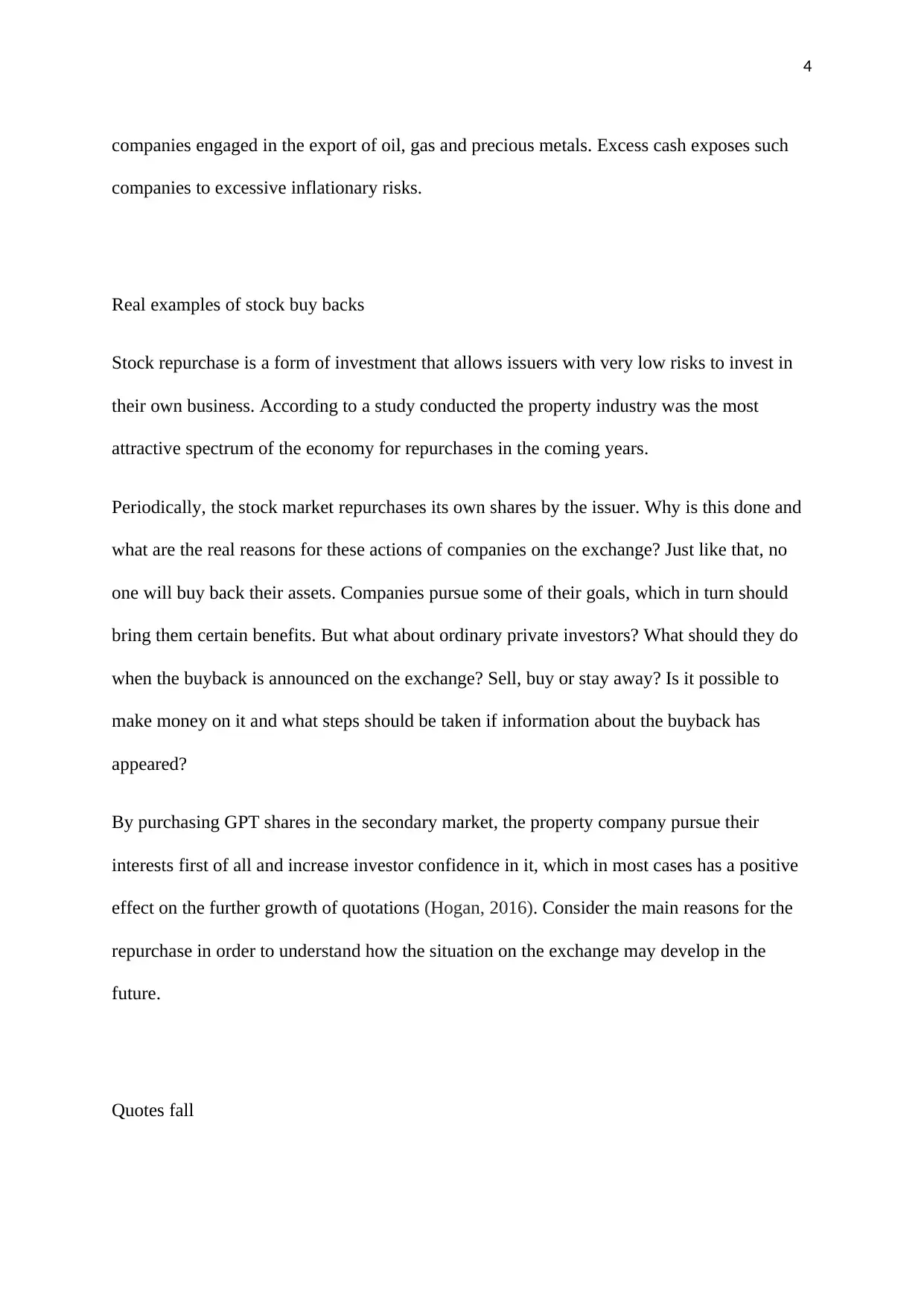
4
companies engaged in the export of oil, gas and precious metals. Excess cash exposes such
companies to excessive inflationary risks.
Real examples of stock buy backs
Stock repurchase is a form of investment that allows issuers with very low risks to invest in
their own business. According to a study conducted the property industry was the most
attractive spectrum of the economy for repurchases in the coming years.
Periodically, the stock market repurchases its own shares by the issuer. Why is this done and
what are the real reasons for these actions of companies on the exchange? Just like that, no
one will buy back their assets. Companies pursue some of their goals, which in turn should
bring them certain benefits. But what about ordinary private investors? What should they do
when the buyback is announced on the exchange? Sell, buy or stay away? Is it possible to
make money on it and what steps should be taken if information about the buyback has
appeared?
By purchasing GPT shares in the secondary market, the property company pursue their
interests first of all and increase investor confidence in it, which in most cases has a positive
effect on the further growth of quotations (Hogan, 2016). Consider the main reasons for the
repurchase in order to understand how the situation on the exchange may develop in the
future.
Quotes fall
companies engaged in the export of oil, gas and precious metals. Excess cash exposes such
companies to excessive inflationary risks.
Real examples of stock buy backs
Stock repurchase is a form of investment that allows issuers with very low risks to invest in
their own business. According to a study conducted the property industry was the most
attractive spectrum of the economy for repurchases in the coming years.
Periodically, the stock market repurchases its own shares by the issuer. Why is this done and
what are the real reasons for these actions of companies on the exchange? Just like that, no
one will buy back their assets. Companies pursue some of their goals, which in turn should
bring them certain benefits. But what about ordinary private investors? What should they do
when the buyback is announced on the exchange? Sell, buy or stay away? Is it possible to
make money on it and what steps should be taken if information about the buyback has
appeared?
By purchasing GPT shares in the secondary market, the property company pursue their
interests first of all and increase investor confidence in it, which in most cases has a positive
effect on the further growth of quotations (Hogan, 2016). Consider the main reasons for the
repurchase in order to understand how the situation on the exchange may develop in the
future.
Quotes fall
Secure Best Marks with AI Grader
Need help grading? Try our AI Grader for instant feedback on your assignments.
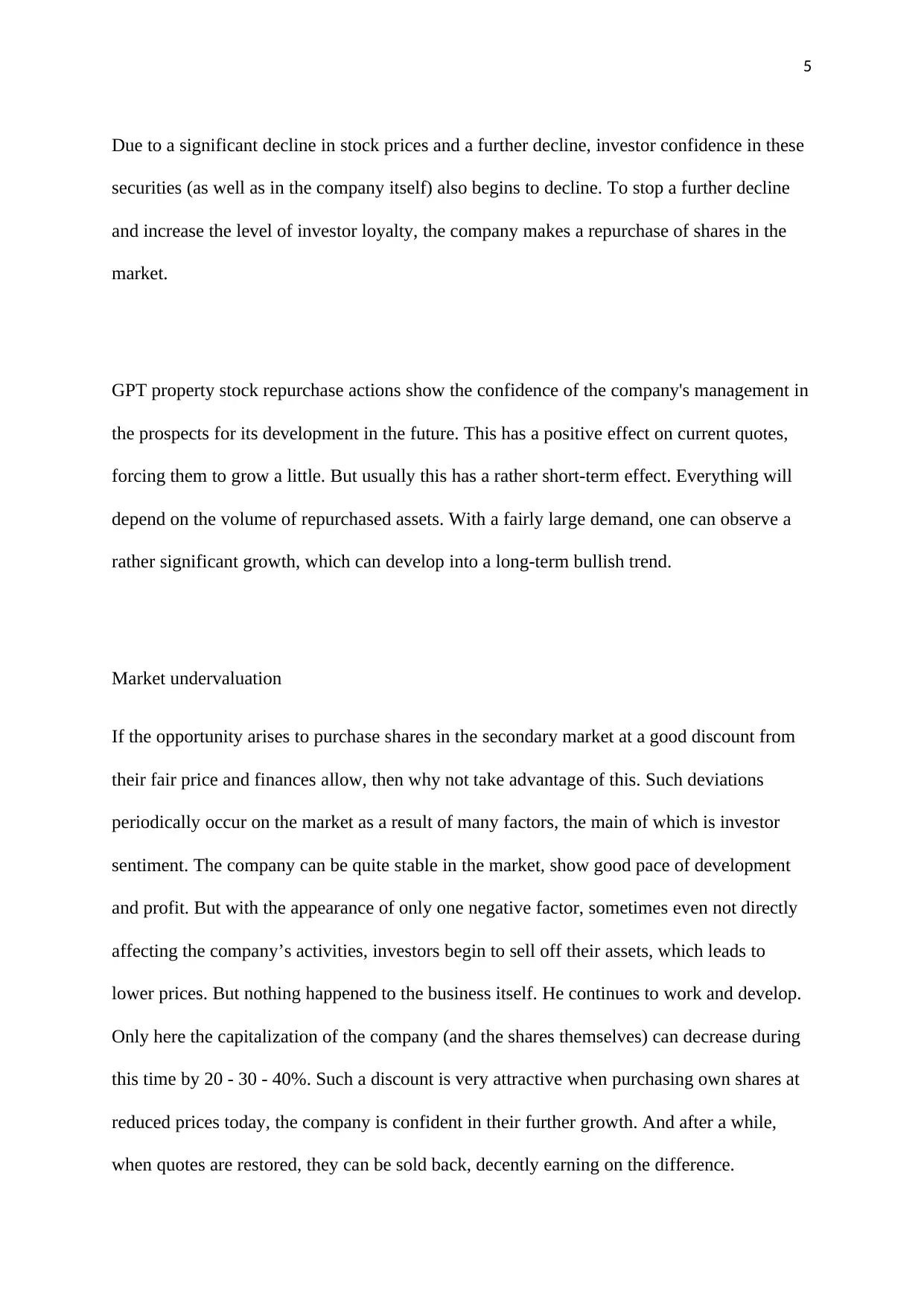
5
Due to a significant decline in stock prices and a further decline, investor confidence in these
securities (as well as in the company itself) also begins to decline. To stop a further decline
and increase the level of investor loyalty, the company makes a repurchase of shares in the
market.
GPT property stock repurchase actions show the confidence of the company's management in
the prospects for its development in the future. This has a positive effect on current quotes,
forcing them to grow a little. But usually this has a rather short-term effect. Everything will
depend on the volume of repurchased assets. With a fairly large demand, one can observe a
rather significant growth, which can develop into a long-term bullish trend.
Market undervaluation
If the opportunity arises to purchase shares in the secondary market at a good discount from
their fair price and finances allow, then why not take advantage of this. Such deviations
periodically occur on the market as a result of many factors, the main of which is investor
sentiment. The company can be quite stable in the market, show good pace of development
and profit. But with the appearance of only one negative factor, sometimes even not directly
affecting the company’s activities, investors begin to sell off their assets, which leads to
lower prices. But nothing happened to the business itself. He continues to work and develop.
Only here the capitalization of the company (and the shares themselves) can decrease during
this time by 20 - 30 - 40%. Such a discount is very attractive when purchasing own shares at
reduced prices today, the company is confident in their further growth. And after a while,
when quotes are restored, they can be sold back, decently earning on the difference.
Due to a significant decline in stock prices and a further decline, investor confidence in these
securities (as well as in the company itself) also begins to decline. To stop a further decline
and increase the level of investor loyalty, the company makes a repurchase of shares in the
market.
GPT property stock repurchase actions show the confidence of the company's management in
the prospects for its development in the future. This has a positive effect on current quotes,
forcing them to grow a little. But usually this has a rather short-term effect. Everything will
depend on the volume of repurchased assets. With a fairly large demand, one can observe a
rather significant growth, which can develop into a long-term bullish trend.
Market undervaluation
If the opportunity arises to purchase shares in the secondary market at a good discount from
their fair price and finances allow, then why not take advantage of this. Such deviations
periodically occur on the market as a result of many factors, the main of which is investor
sentiment. The company can be quite stable in the market, show good pace of development
and profit. But with the appearance of only one negative factor, sometimes even not directly
affecting the company’s activities, investors begin to sell off their assets, which leads to
lower prices. But nothing happened to the business itself. He continues to work and develop.
Only here the capitalization of the company (and the shares themselves) can decrease during
this time by 20 - 30 - 40%. Such a discount is very attractive when purchasing own shares at
reduced prices today, the company is confident in their further growth. And after a while,
when quotes are restored, they can be sold back, decently earning on the difference.
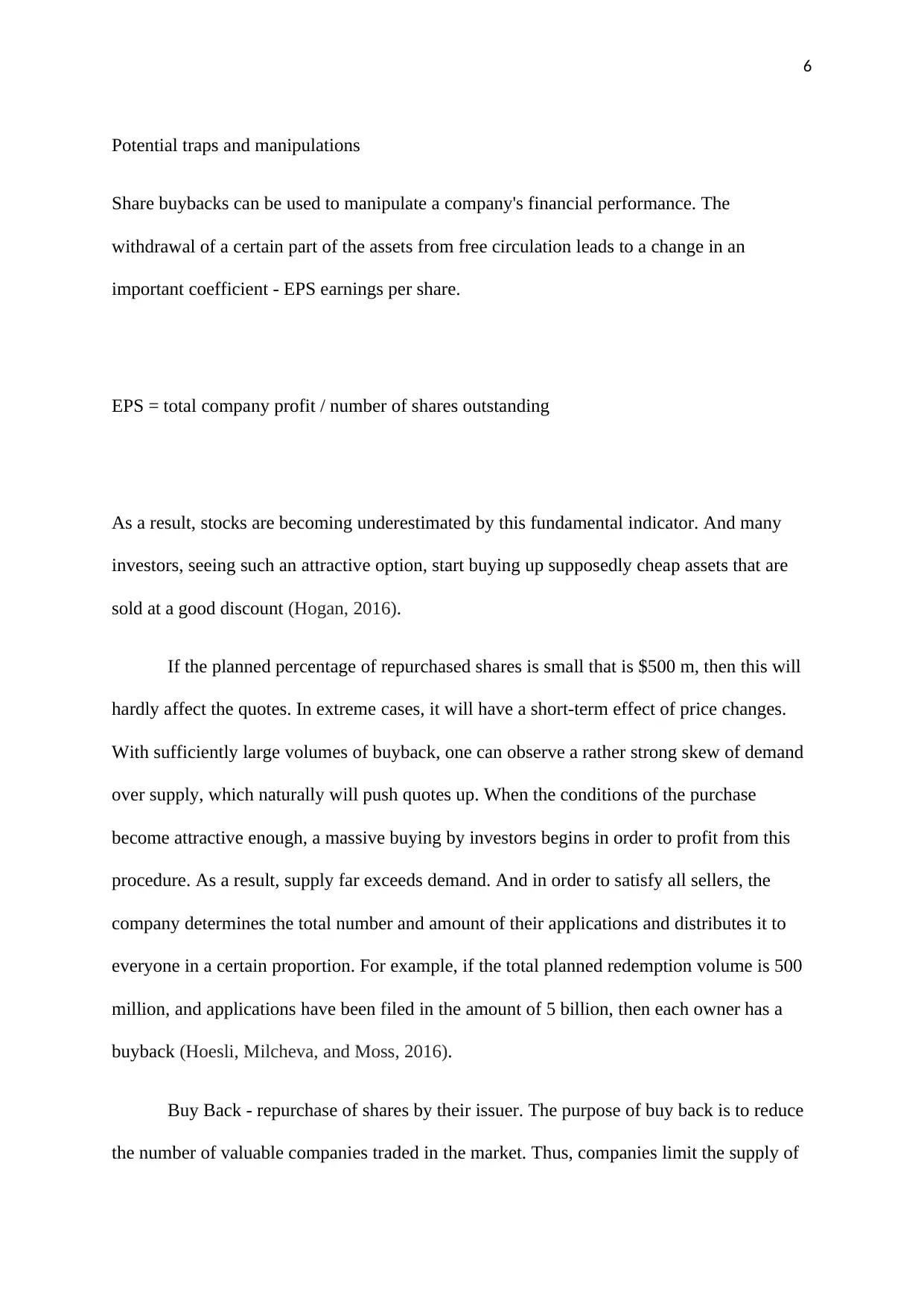
6
Potential traps and manipulations
Share buybacks can be used to manipulate a company's financial performance. The
withdrawal of a certain part of the assets from free circulation leads to a change in an
important coefficient - EPS earnings per share.
EPS = total company profit / number of shares outstanding
As a result, stocks are becoming underestimated by this fundamental indicator. And many
investors, seeing such an attractive option, start buying up supposedly cheap assets that are
sold at a good discount (Hogan, 2016).
If the planned percentage of repurchased shares is small that is $500 m, then this will
hardly affect the quotes. In extreme cases, it will have a short-term effect of price changes.
With sufficiently large volumes of buyback, one can observe a rather strong skew of demand
over supply, which naturally will push quotes up. When the conditions of the purchase
become attractive enough, a massive buying by investors begins in order to profit from this
procedure. As a result, supply far exceeds demand. And in order to satisfy all sellers, the
company determines the total number and amount of their applications and distributes it to
everyone in a certain proportion. For example, if the total planned redemption volume is 500
million, and applications have been filed in the amount of 5 billion, then each owner has a
buyback (Hoesli, Milcheva, and Moss, 2016).
Buy Back - repurchase of shares by their issuer. The purpose of buy back is to reduce
the number of valuable companies traded in the market. Thus, companies limit the supply of
Potential traps and manipulations
Share buybacks can be used to manipulate a company's financial performance. The
withdrawal of a certain part of the assets from free circulation leads to a change in an
important coefficient - EPS earnings per share.
EPS = total company profit / number of shares outstanding
As a result, stocks are becoming underestimated by this fundamental indicator. And many
investors, seeing such an attractive option, start buying up supposedly cheap assets that are
sold at a good discount (Hogan, 2016).
If the planned percentage of repurchased shares is small that is $500 m, then this will
hardly affect the quotes. In extreme cases, it will have a short-term effect of price changes.
With sufficiently large volumes of buyback, one can observe a rather strong skew of demand
over supply, which naturally will push quotes up. When the conditions of the purchase
become attractive enough, a massive buying by investors begins in order to profit from this
procedure. As a result, supply far exceeds demand. And in order to satisfy all sellers, the
company determines the total number and amount of their applications and distributes it to
everyone in a certain proportion. For example, if the total planned redemption volume is 500
million, and applications have been filed in the amount of 5 billion, then each owner has a
buyback (Hoesli, Milcheva, and Moss, 2016).
Buy Back - repurchase of shares by their issuer. The purpose of buy back is to reduce
the number of valuable companies traded in the market. Thus, companies limit the supply of
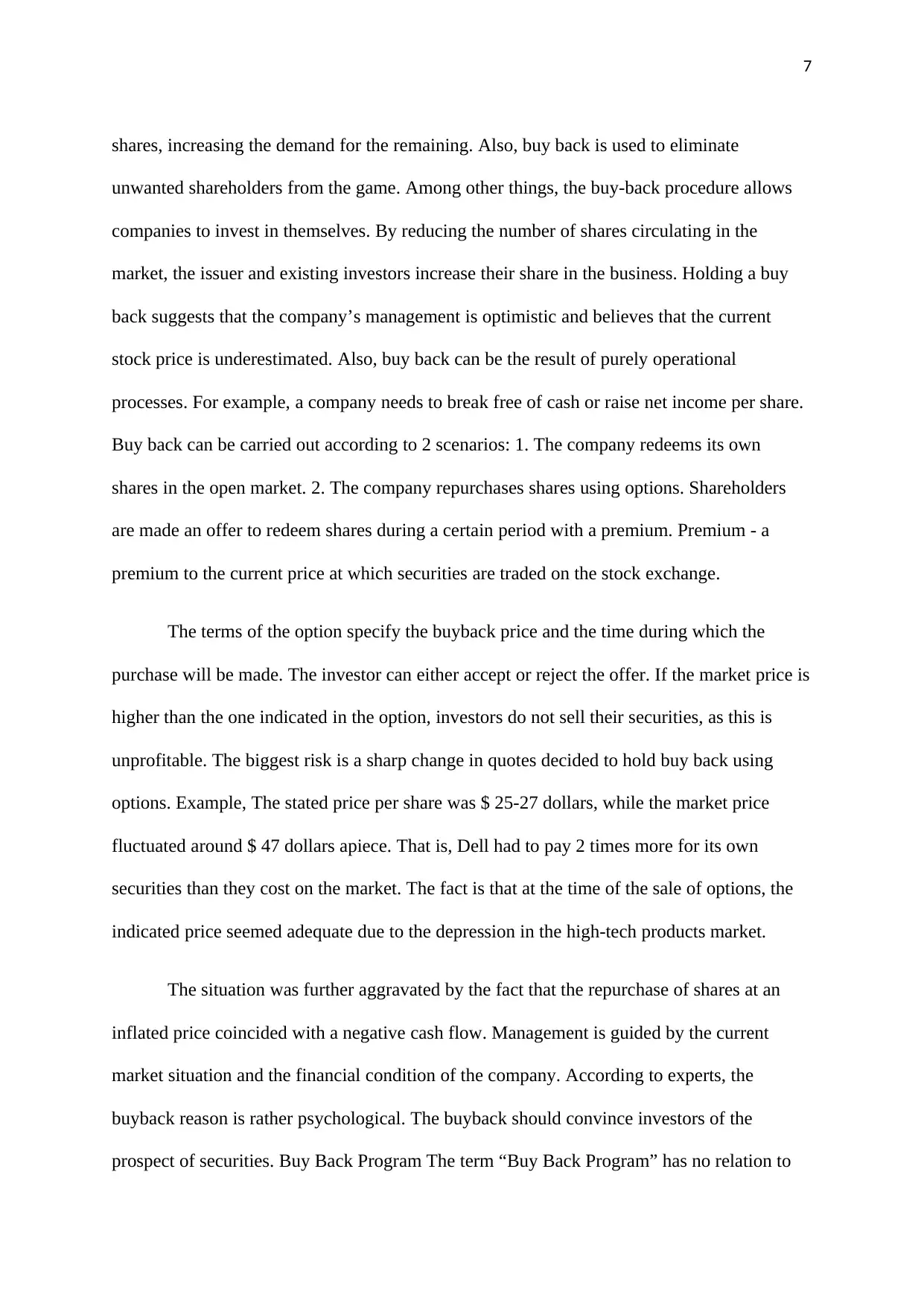
7
shares, increasing the demand for the remaining. Also, buy back is used to eliminate
unwanted shareholders from the game. Among other things, the buy-back procedure allows
companies to invest in themselves. By reducing the number of shares circulating in the
market, the issuer and existing investors increase their share in the business. Holding a buy
back suggests that the company’s management is optimistic and believes that the current
stock price is underestimated. Also, buy back can be the result of purely operational
processes. For example, a company needs to break free of cash or raise net income per share.
Buy back can be carried out according to 2 scenarios: 1. The company redeems its own
shares in the open market. 2. The company repurchases shares using options. Shareholders
are made an offer to redeem shares during a certain period with a premium. Premium - a
premium to the current price at which securities are traded on the stock exchange.
The terms of the option specify the buyback price and the time during which the
purchase will be made. The investor can either accept or reject the offer. If the market price is
higher than the one indicated in the option, investors do not sell their securities, as this is
unprofitable. The biggest risk is a sharp change in quotes decided to hold buy back using
options. Example, The stated price per share was $ 25-27 dollars, while the market price
fluctuated around $ 47 dollars apiece. That is, Dell had to pay 2 times more for its own
securities than they cost on the market. The fact is that at the time of the sale of options, the
indicated price seemed adequate due to the depression in the high-tech products market.
The situation was further aggravated by the fact that the repurchase of shares at an
inflated price coincided with a negative cash flow. Management is guided by the current
market situation and the financial condition of the company. According to experts, the
buyback reason is rather psychological. The buyback should convince investors of the
prospect of securities. Buy Back Program The term “Buy Back Program” has no relation to
shares, increasing the demand for the remaining. Also, buy back is used to eliminate
unwanted shareholders from the game. Among other things, the buy-back procedure allows
companies to invest in themselves. By reducing the number of shares circulating in the
market, the issuer and existing investors increase their share in the business. Holding a buy
back suggests that the company’s management is optimistic and believes that the current
stock price is underestimated. Also, buy back can be the result of purely operational
processes. For example, a company needs to break free of cash or raise net income per share.
Buy back can be carried out according to 2 scenarios: 1. The company redeems its own
shares in the open market. 2. The company repurchases shares using options. Shareholders
are made an offer to redeem shares during a certain period with a premium. Premium - a
premium to the current price at which securities are traded on the stock exchange.
The terms of the option specify the buyback price and the time during which the
purchase will be made. The investor can either accept or reject the offer. If the market price is
higher than the one indicated in the option, investors do not sell their securities, as this is
unprofitable. The biggest risk is a sharp change in quotes decided to hold buy back using
options. Example, The stated price per share was $ 25-27 dollars, while the market price
fluctuated around $ 47 dollars apiece. That is, Dell had to pay 2 times more for its own
securities than they cost on the market. The fact is that at the time of the sale of options, the
indicated price seemed adequate due to the depression in the high-tech products market.
The situation was further aggravated by the fact that the repurchase of shares at an
inflated price coincided with a negative cash flow. Management is guided by the current
market situation and the financial condition of the company. According to experts, the
buyback reason is rather psychological. The buyback should convince investors of the
prospect of securities. Buy Back Program The term “Buy Back Program” has no relation to
Paraphrase This Document
Need a fresh take? Get an instant paraphrase of this document with our AI Paraphraser
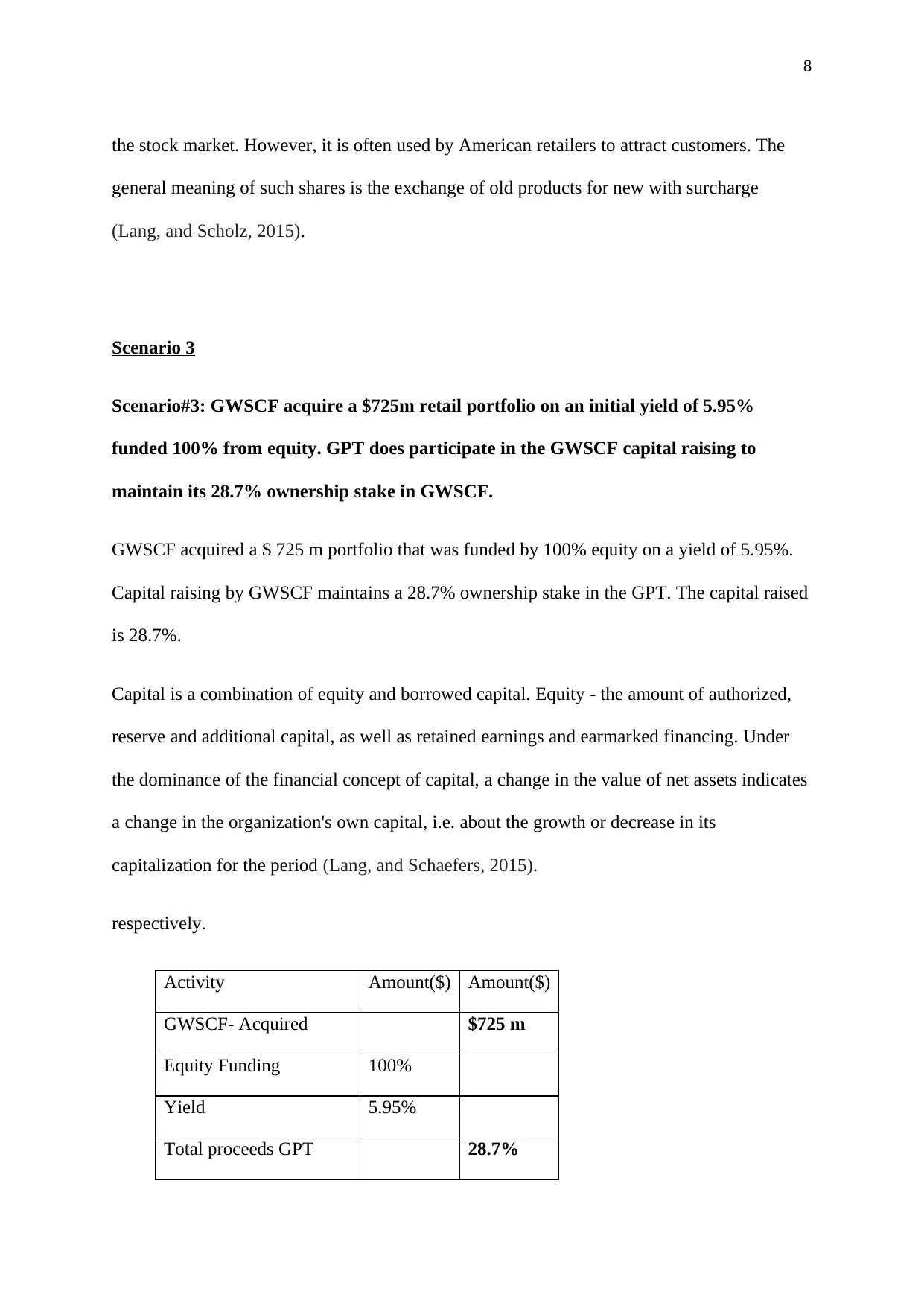
8
the stock market. However, it is often used by American retailers to attract customers. The
general meaning of such shares is the exchange of old products for new with surcharge
(Lang, and Scholz, 2015).
Scenario 3
Scenario#3: GWSCF acquire a $725m retail portfolio on an initial yield of 5.95%
funded 100% from equity. GPT does participate in the GWSCF capital raising to
maintain its 28.7% ownership stake in GWSCF.
GWSCF acquired a $ 725 m portfolio that was funded by 100% equity on a yield of 5.95%.
Capital raising by GWSCF maintains a 28.7% ownership stake in the GPT. The capital raised
is 28.7%.
Capital is a combination of equity and borrowed capital. Equity - the amount of authorized,
reserve and additional capital, as well as retained earnings and earmarked financing. Under
the dominance of the financial concept of capital, a change in the value of net assets indicates
a change in the organization's own capital, i.e. about the growth or decrease in its
capitalization for the period (Lang, and Schaefers, 2015).
respectively.
Activity Amount($) Amount($)
GWSCF- Acquired $725 m
Equity Funding 100%
Yield 5.95%
Total proceeds GPT 28.7%
the stock market. However, it is often used by American retailers to attract customers. The
general meaning of such shares is the exchange of old products for new with surcharge
(Lang, and Scholz, 2015).
Scenario 3
Scenario#3: GWSCF acquire a $725m retail portfolio on an initial yield of 5.95%
funded 100% from equity. GPT does participate in the GWSCF capital raising to
maintain its 28.7% ownership stake in GWSCF.
GWSCF acquired a $ 725 m portfolio that was funded by 100% equity on a yield of 5.95%.
Capital raising by GWSCF maintains a 28.7% ownership stake in the GPT. The capital raised
is 28.7%.
Capital is a combination of equity and borrowed capital. Equity - the amount of authorized,
reserve and additional capital, as well as retained earnings and earmarked financing. Under
the dominance of the financial concept of capital, a change in the value of net assets indicates
a change in the organization's own capital, i.e. about the growth or decrease in its
capitalization for the period (Lang, and Schaefers, 2015).
respectively.
Activity Amount($) Amount($)
GWSCF- Acquired $725 m
Equity Funding 100%
Yield 5.95%
Total proceeds GPT 28.7%
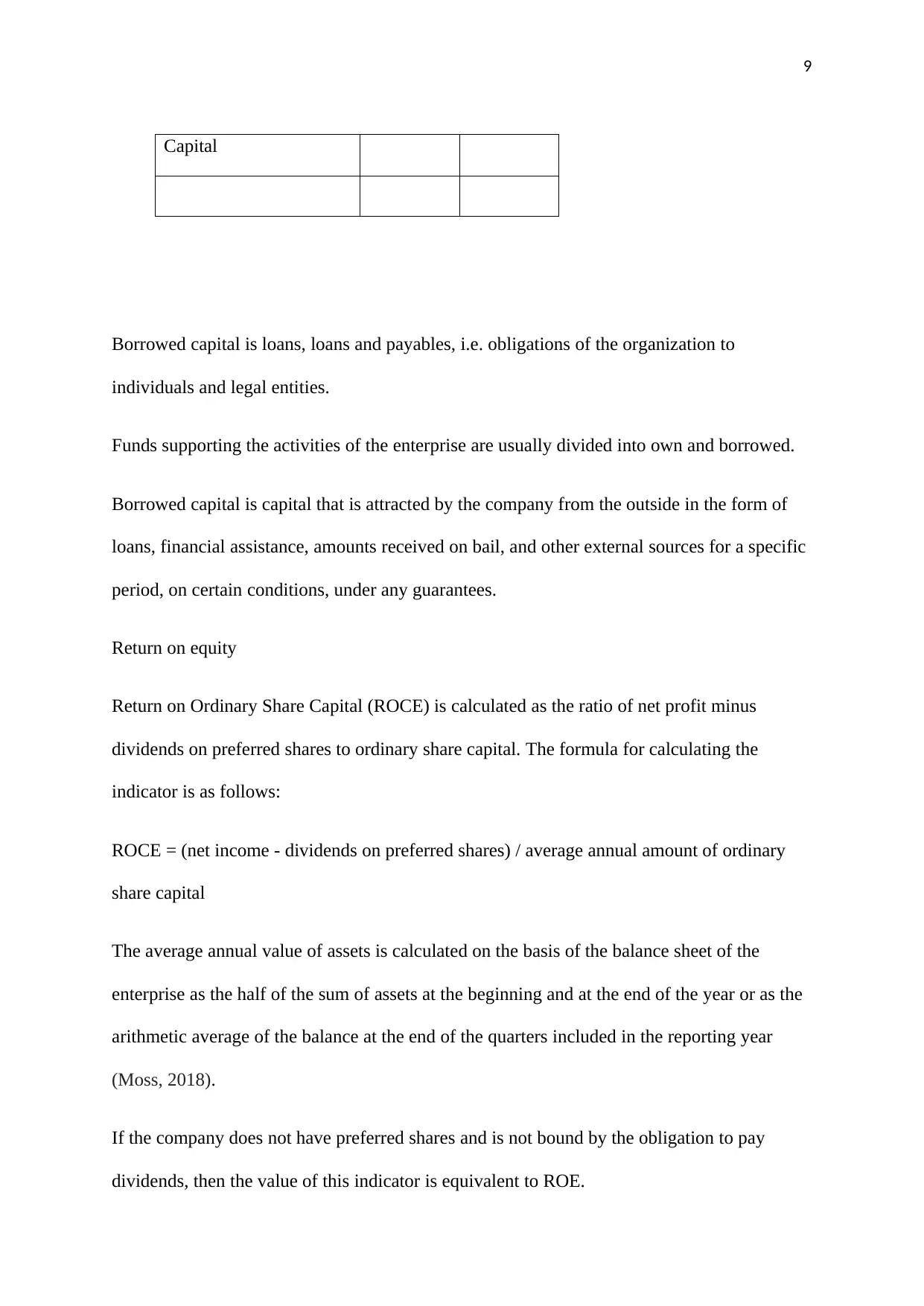
9
Capital
Borrowed capital is loans, loans and payables, i.e. obligations of the organization to
individuals and legal entities.
Funds supporting the activities of the enterprise are usually divided into own and borrowed.
Borrowed capital is capital that is attracted by the company from the outside in the form of
loans, financial assistance, amounts received on bail, and other external sources for a specific
period, on certain conditions, under any guarantees.
Return on equity
Return on Ordinary Share Capital (ROCE) is calculated as the ratio of net profit minus
dividends on preferred shares to ordinary share capital. The formula for calculating the
indicator is as follows:
ROCE = (net income - dividends on preferred shares) / average annual amount of ordinary
share capital
The average annual value of assets is calculated on the basis of the balance sheet of the
enterprise as the half of the sum of assets at the beginning and at the end of the year or as the
arithmetic average of the balance at the end of the quarters included in the reporting year
(Moss, 2018).
If the company does not have preferred shares and is not bound by the obligation to pay
dividends, then the value of this indicator is equivalent to ROE.
Capital
Borrowed capital is loans, loans and payables, i.e. obligations of the organization to
individuals and legal entities.
Funds supporting the activities of the enterprise are usually divided into own and borrowed.
Borrowed capital is capital that is attracted by the company from the outside in the form of
loans, financial assistance, amounts received on bail, and other external sources for a specific
period, on certain conditions, under any guarantees.
Return on equity
Return on Ordinary Share Capital (ROCE) is calculated as the ratio of net profit minus
dividends on preferred shares to ordinary share capital. The formula for calculating the
indicator is as follows:
ROCE = (net income - dividends on preferred shares) / average annual amount of ordinary
share capital
The average annual value of assets is calculated on the basis of the balance sheet of the
enterprise as the half of the sum of assets at the beginning and at the end of the year or as the
arithmetic average of the balance at the end of the quarters included in the reporting year
(Moss, 2018).
If the company does not have preferred shares and is not bound by the obligation to pay
dividends, then the value of this indicator is equivalent to ROE.
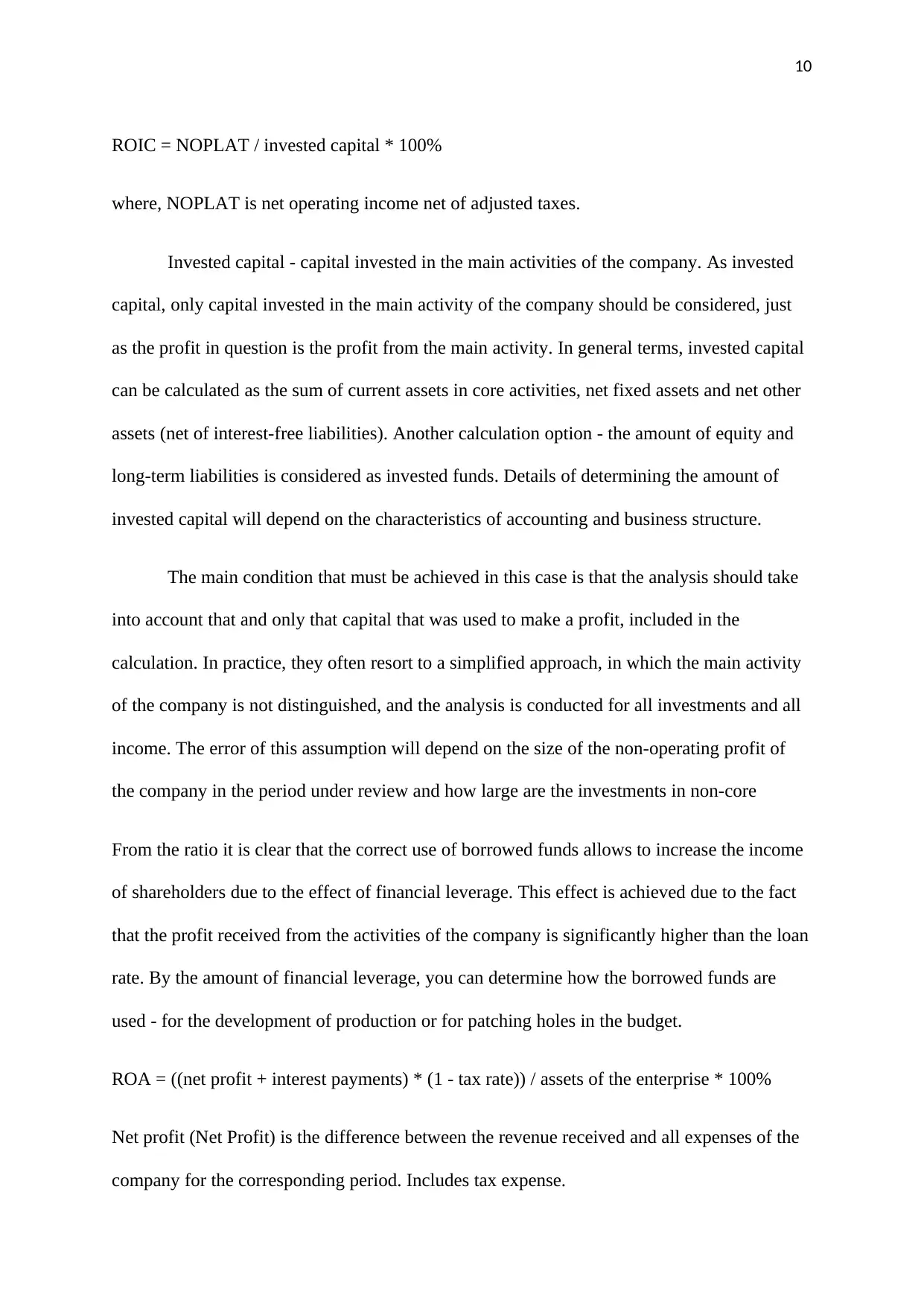
10
ROIC = NOPLAT / invested capital * 100%
where, NOPLAT is net operating income net of adjusted taxes.
Invested capital - capital invested in the main activities of the company. As invested
capital, only capital invested in the main activity of the company should be considered, just
as the profit in question is the profit from the main activity. In general terms, invested capital
can be calculated as the sum of current assets in core activities, net fixed assets and net other
assets (net of interest-free liabilities). Another calculation option - the amount of equity and
long-term liabilities is considered as invested funds. Details of determining the amount of
invested capital will depend on the characteristics of accounting and business structure.
The main condition that must be achieved in this case is that the analysis should take
into account that and only that capital that was used to make a profit, included in the
calculation. In practice, they often resort to a simplified approach, in which the main activity
of the company is not distinguished, and the analysis is conducted for all investments and all
income. The error of this assumption will depend on the size of the non-operating profit of
the company in the period under review and how large are the investments in non-core
From the ratio it is clear that the correct use of borrowed funds allows to increase the income
of shareholders due to the effect of financial leverage. This effect is achieved due to the fact
that the profit received from the activities of the company is significantly higher than the loan
rate. By the amount of financial leverage, you can determine how the borrowed funds are
used - for the development of production or for patching holes in the budget.
ROA = ((net profit + interest payments) * (1 - tax rate)) / assets of the enterprise * 100%
Net profit (Net Profit) is the difference between the revenue received and all expenses of the
company for the corresponding period. Includes tax expense.
ROIC = NOPLAT / invested capital * 100%
where, NOPLAT is net operating income net of adjusted taxes.
Invested capital - capital invested in the main activities of the company. As invested
capital, only capital invested in the main activity of the company should be considered, just
as the profit in question is the profit from the main activity. In general terms, invested capital
can be calculated as the sum of current assets in core activities, net fixed assets and net other
assets (net of interest-free liabilities). Another calculation option - the amount of equity and
long-term liabilities is considered as invested funds. Details of determining the amount of
invested capital will depend on the characteristics of accounting and business structure.
The main condition that must be achieved in this case is that the analysis should take
into account that and only that capital that was used to make a profit, included in the
calculation. In practice, they often resort to a simplified approach, in which the main activity
of the company is not distinguished, and the analysis is conducted for all investments and all
income. The error of this assumption will depend on the size of the non-operating profit of
the company in the period under review and how large are the investments in non-core
From the ratio it is clear that the correct use of borrowed funds allows to increase the income
of shareholders due to the effect of financial leverage. This effect is achieved due to the fact
that the profit received from the activities of the company is significantly higher than the loan
rate. By the amount of financial leverage, you can determine how the borrowed funds are
used - for the development of production or for patching holes in the budget.
ROA = ((net profit + interest payments) * (1 - tax rate)) / assets of the enterprise * 100%
Net profit (Net Profit) is the difference between the revenue received and all expenses of the
company for the corresponding period. Includes tax expense.
Secure Best Marks with AI Grader
Need help grading? Try our AI Grader for instant feedback on your assignments.
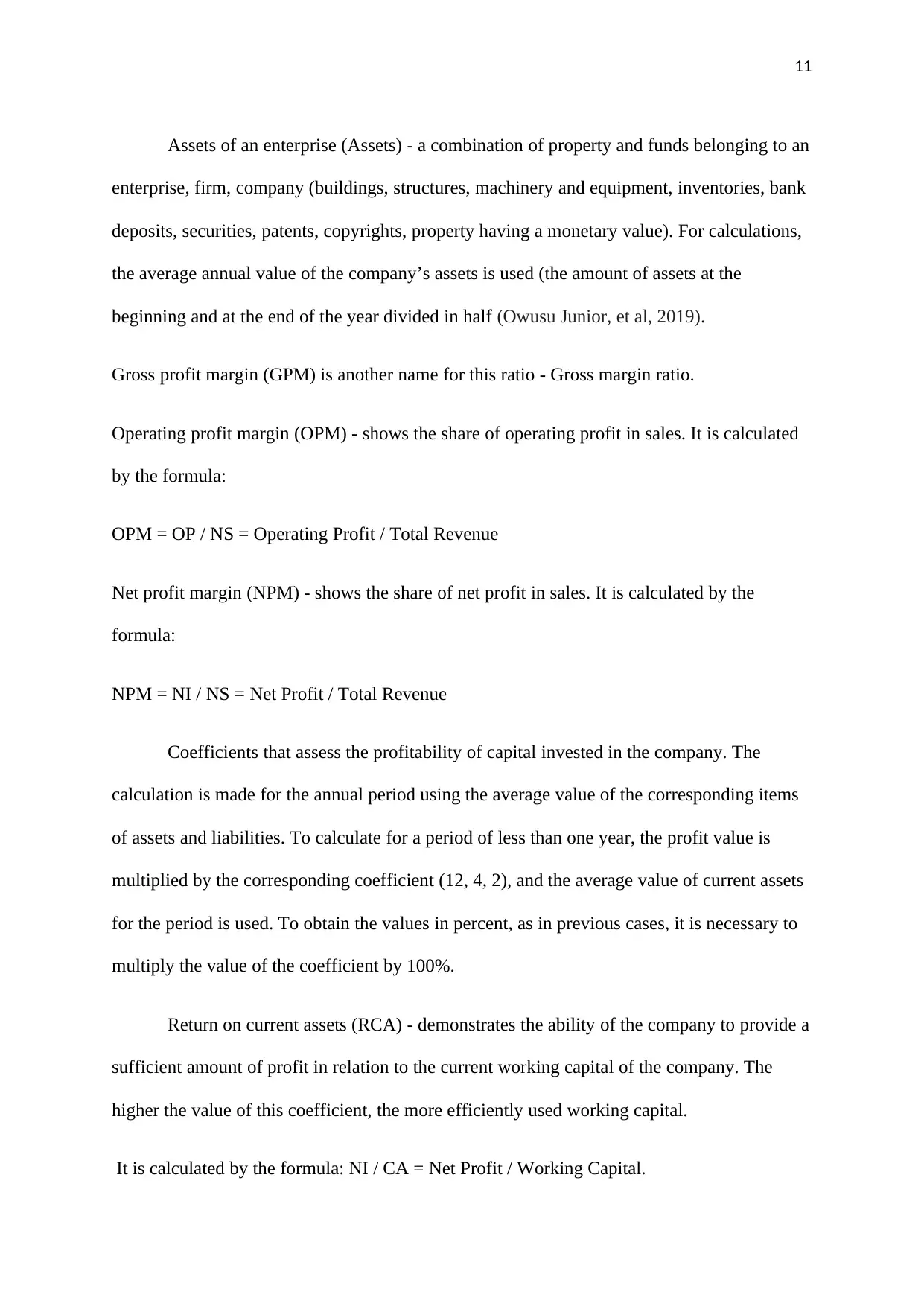
11
Assets of an enterprise (Assets) - a combination of property and funds belonging to an
enterprise, firm, company (buildings, structures, machinery and equipment, inventories, bank
deposits, securities, patents, copyrights, property having a monetary value). For calculations,
the average annual value of the company’s assets is used (the amount of assets at the
beginning and at the end of the year divided in half (Owusu Junior, et al, 2019).
Gross profit margin (GPM) is another name for this ratio - Gross margin ratio.
Operating profit margin (OPM) - shows the share of operating profit in sales. It is calculated
by the formula:
OPM = OP / NS = Operating Profit / Total Revenue
Net profit margin (NPM) - shows the share of net profit in sales. It is calculated by the
formula:
NPM = NI / NS = Net Profit / Total Revenue
Coefficients that assess the profitability of capital invested in the company. The
calculation is made for the annual period using the average value of the corresponding items
of assets and liabilities. To calculate for a period of less than one year, the profit value is
multiplied by the corresponding coefficient (12, 4, 2), and the average value of current assets
for the period is used. To obtain the values in percent, as in previous cases, it is necessary to
multiply the value of the coefficient by 100%.
Return on current assets (RCA) - demonstrates the ability of the company to provide a
sufficient amount of profit in relation to the current working capital of the company. The
higher the value of this coefficient, the more efficiently used working capital.
It is calculated by the formula: NI / CA = Net Profit / Working Capital.
Assets of an enterprise (Assets) - a combination of property and funds belonging to an
enterprise, firm, company (buildings, structures, machinery and equipment, inventories, bank
deposits, securities, patents, copyrights, property having a monetary value). For calculations,
the average annual value of the company’s assets is used (the amount of assets at the
beginning and at the end of the year divided in half (Owusu Junior, et al, 2019).
Gross profit margin (GPM) is another name for this ratio - Gross margin ratio.
Operating profit margin (OPM) - shows the share of operating profit in sales. It is calculated
by the formula:
OPM = OP / NS = Operating Profit / Total Revenue
Net profit margin (NPM) - shows the share of net profit in sales. It is calculated by the
formula:
NPM = NI / NS = Net Profit / Total Revenue
Coefficients that assess the profitability of capital invested in the company. The
calculation is made for the annual period using the average value of the corresponding items
of assets and liabilities. To calculate for a period of less than one year, the profit value is
multiplied by the corresponding coefficient (12, 4, 2), and the average value of current assets
for the period is used. To obtain the values in percent, as in previous cases, it is necessary to
multiply the value of the coefficient by 100%.
Return on current assets (RCA) - demonstrates the ability of the company to provide a
sufficient amount of profit in relation to the current working capital of the company. The
higher the value of this coefficient, the more efficiently used working capital.
It is calculated by the formula: NI / CA = Net Profit / Working Capital.
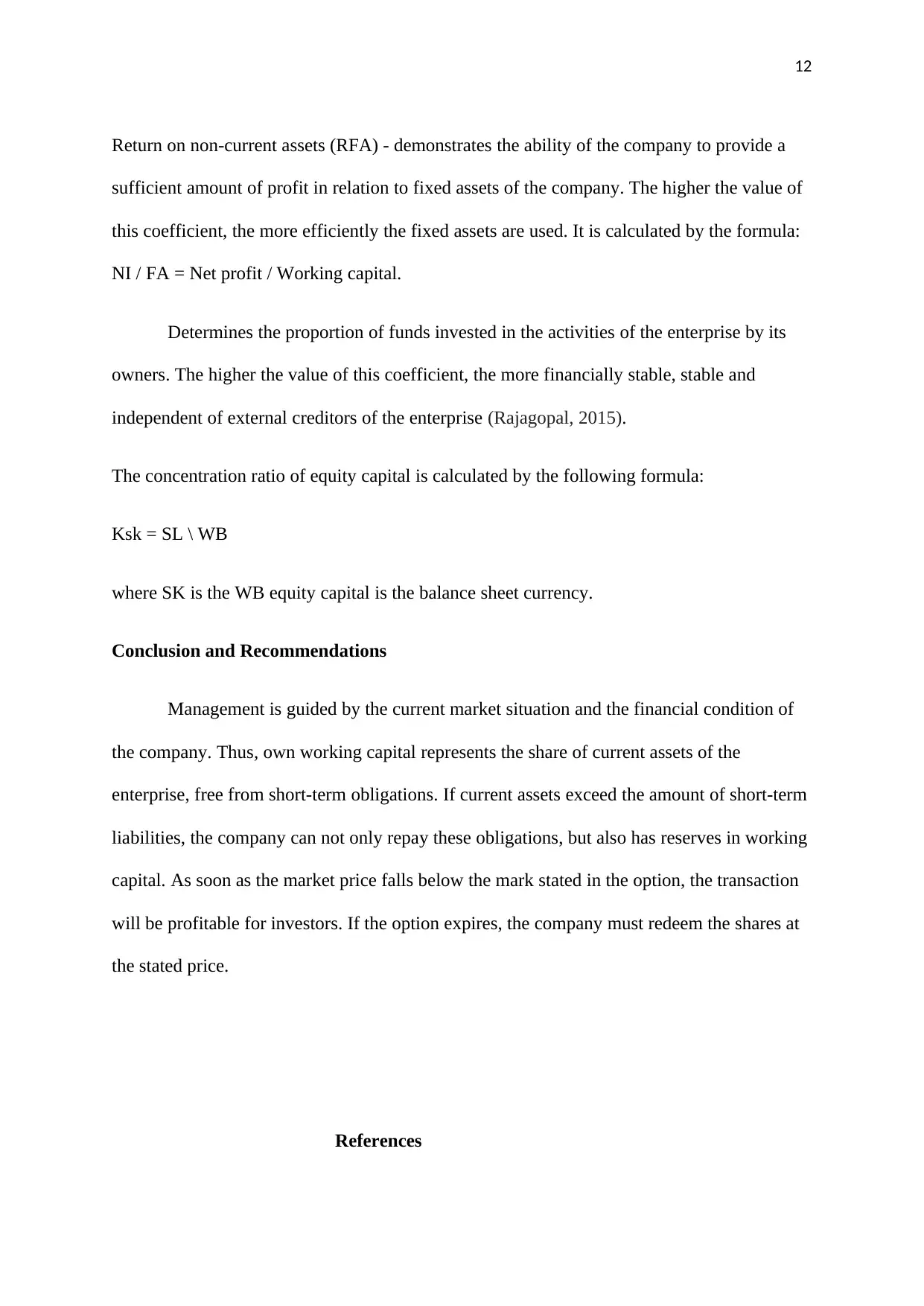
12
Return on non-current assets (RFA) - demonstrates the ability of the company to provide a
sufficient amount of profit in relation to fixed assets of the company. The higher the value of
this coefficient, the more efficiently the fixed assets are used. It is calculated by the formula:
NI / FA = Net profit / Working capital.
Determines the proportion of funds invested in the activities of the enterprise by its
owners. The higher the value of this coefficient, the more financially stable, stable and
independent of external creditors of the enterprise (Rajagopal, 2015).
The concentration ratio of equity capital is calculated by the following formula:
Ksk = SL \ WB
where SK is the WB equity capital is the balance sheet currency.
Conclusion and Recommendations
Management is guided by the current market situation and the financial condition of
the company. Thus, own working capital represents the share of current assets of the
enterprise, free from short-term obligations. If current assets exceed the amount of short-term
liabilities, the company can not only repay these obligations, but also has reserves in working
capital. As soon as the market price falls below the mark stated in the option, the transaction
will be profitable for investors. If the option expires, the company must redeem the shares at
the stated price.
References
Return on non-current assets (RFA) - demonstrates the ability of the company to provide a
sufficient amount of profit in relation to fixed assets of the company. The higher the value of
this coefficient, the more efficiently the fixed assets are used. It is calculated by the formula:
NI / FA = Net profit / Working capital.
Determines the proportion of funds invested in the activities of the enterprise by its
owners. The higher the value of this coefficient, the more financially stable, stable and
independent of external creditors of the enterprise (Rajagopal, 2015).
The concentration ratio of equity capital is calculated by the following formula:
Ksk = SL \ WB
where SK is the WB equity capital is the balance sheet currency.
Conclusion and Recommendations
Management is guided by the current market situation and the financial condition of
the company. Thus, own working capital represents the share of current assets of the
enterprise, free from short-term obligations. If current assets exceed the amount of short-term
liabilities, the company can not only repay these obligations, but also has reserves in working
capital. As soon as the market price falls below the mark stated in the option, the transaction
will be profitable for investors. If the option expires, the company must redeem the shares at
the stated price.
References
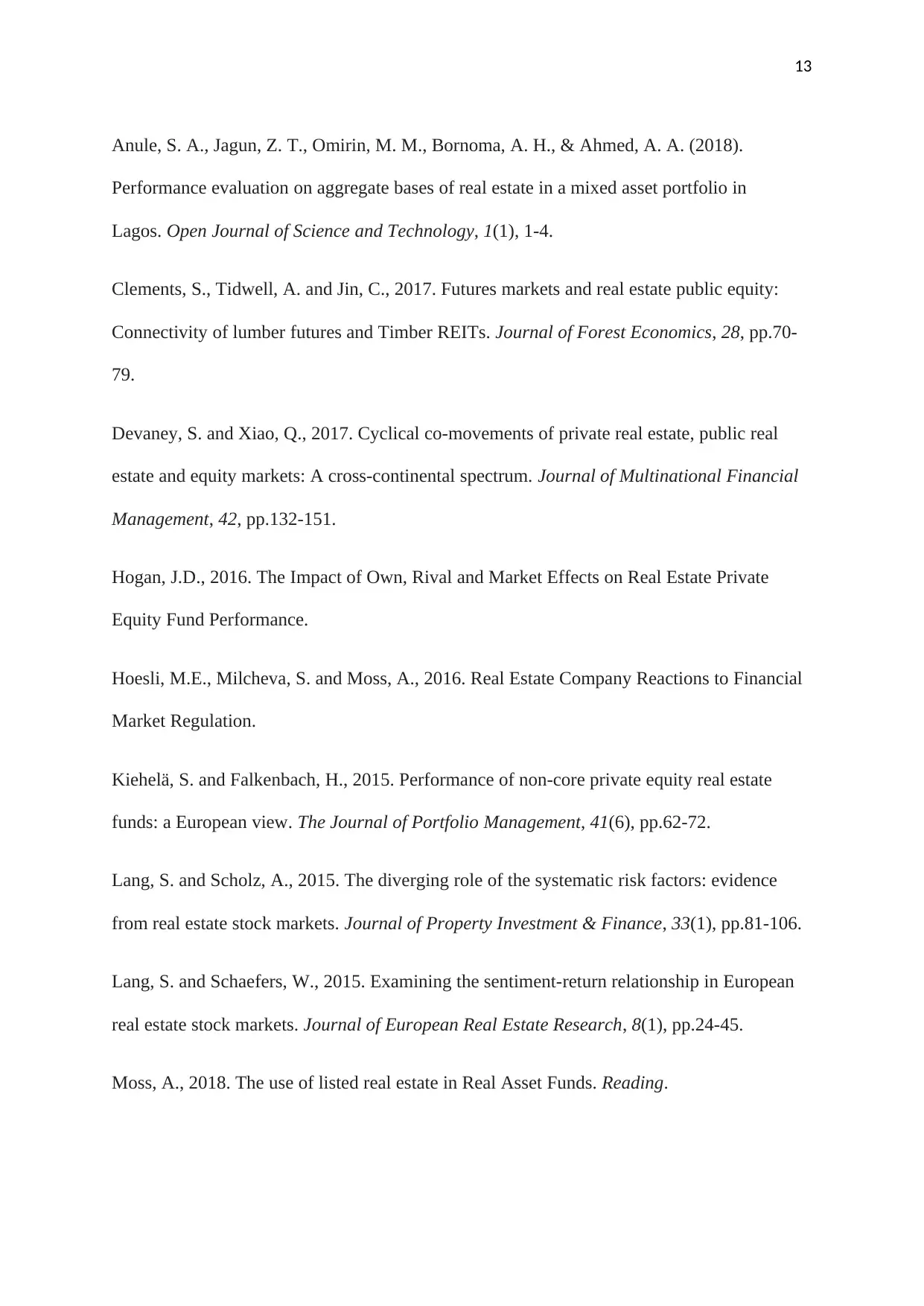
13
Anule, S. A., Jagun, Z. T., Omirin, M. M., Bornoma, A. H., & Ahmed, A. A. (2018).
Performance evaluation on aggregate bases of real estate in a mixed asset portfolio in
Lagos. Open Journal of Science and Technology, 1(1), 1-4.
Clements, S., Tidwell, A. and Jin, C., 2017. Futures markets and real estate public equity:
Connectivity of lumber futures and Timber REITs. Journal of Forest Economics, 28, pp.70-
79.
Devaney, S. and Xiao, Q., 2017. Cyclical co-movements of private real estate, public real
estate and equity markets: A cross-continental spectrum. Journal of Multinational Financial
Management, 42, pp.132-151.
Hogan, J.D., 2016. The Impact of Own, Rival and Market Effects on Real Estate Private
Equity Fund Performance.
Hoesli, M.E., Milcheva, S. and Moss, A., 2016. Real Estate Company Reactions to Financial
Market Regulation.
Kiehelä, S. and Falkenbach, H., 2015. Performance of non-core private equity real estate
funds: a European view. The Journal of Portfolio Management, 41(6), pp.62-72.
Lang, S. and Scholz, A., 2015. The diverging role of the systematic risk factors: evidence
from real estate stock markets. Journal of Property Investment & Finance, 33(1), pp.81-106.
Lang, S. and Schaefers, W., 2015. Examining the sentiment-return relationship in European
real estate stock markets. Journal of European Real Estate Research, 8(1), pp.24-45.
Moss, A., 2018. The use of listed real estate in Real Asset Funds. Reading.
Anule, S. A., Jagun, Z. T., Omirin, M. M., Bornoma, A. H., & Ahmed, A. A. (2018).
Performance evaluation on aggregate bases of real estate in a mixed asset portfolio in
Lagos. Open Journal of Science and Technology, 1(1), 1-4.
Clements, S., Tidwell, A. and Jin, C., 2017. Futures markets and real estate public equity:
Connectivity of lumber futures and Timber REITs. Journal of Forest Economics, 28, pp.70-
79.
Devaney, S. and Xiao, Q., 2017. Cyclical co-movements of private real estate, public real
estate and equity markets: A cross-continental spectrum. Journal of Multinational Financial
Management, 42, pp.132-151.
Hogan, J.D., 2016. The Impact of Own, Rival and Market Effects on Real Estate Private
Equity Fund Performance.
Hoesli, M.E., Milcheva, S. and Moss, A., 2016. Real Estate Company Reactions to Financial
Market Regulation.
Kiehelä, S. and Falkenbach, H., 2015. Performance of non-core private equity real estate
funds: a European view. The Journal of Portfolio Management, 41(6), pp.62-72.
Lang, S. and Scholz, A., 2015. The diverging role of the systematic risk factors: evidence
from real estate stock markets. Journal of Property Investment & Finance, 33(1), pp.81-106.
Lang, S. and Schaefers, W., 2015. Examining the sentiment-return relationship in European
real estate stock markets. Journal of European Real Estate Research, 8(1), pp.24-45.
Moss, A., 2018. The use of listed real estate in Real Asset Funds. Reading.
Paraphrase This Document
Need a fresh take? Get an instant paraphrase of this document with our AI Paraphraser
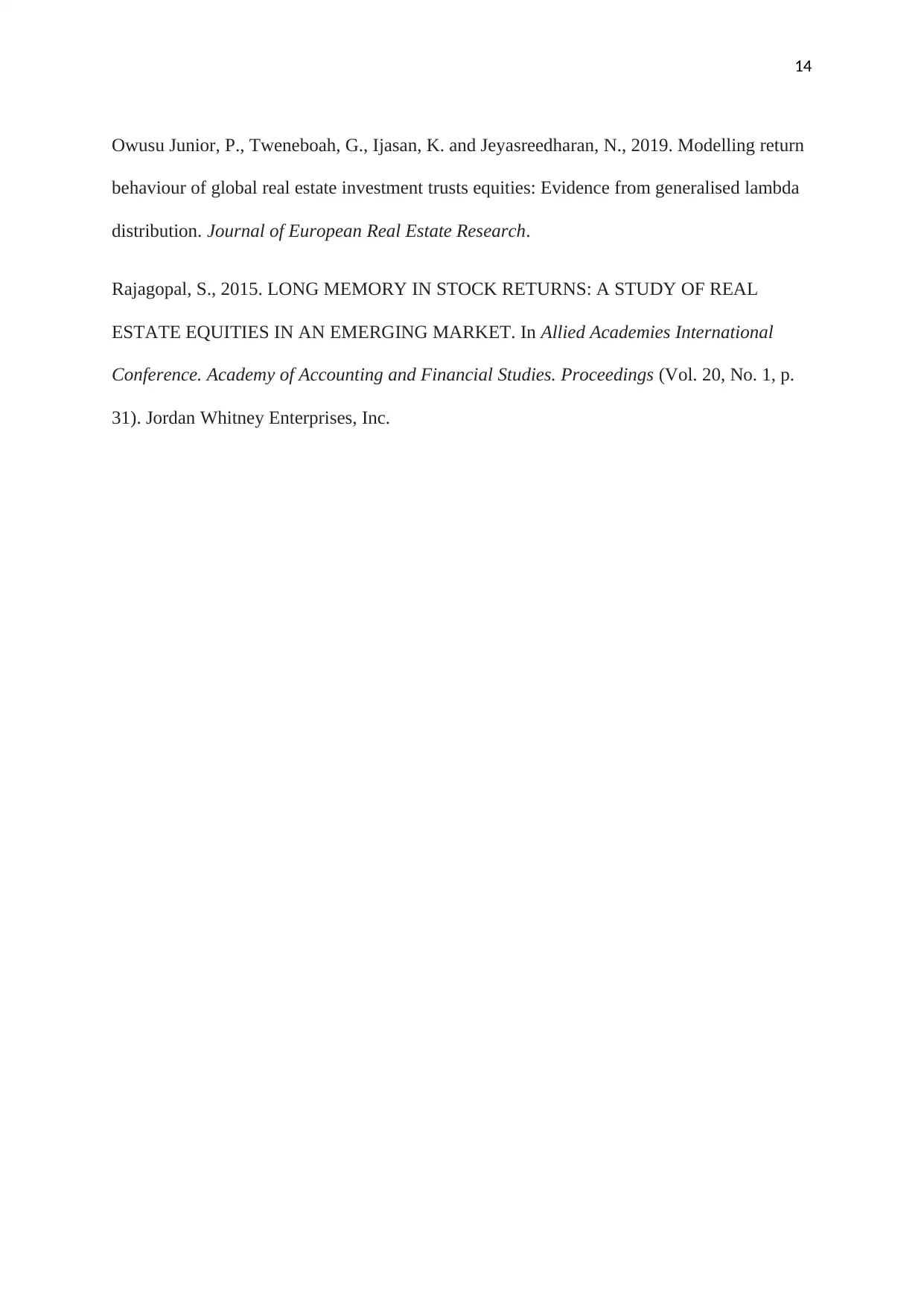
14
Owusu Junior, P., Tweneboah, G., Ijasan, K. and Jeyasreedharan, N., 2019. Modelling return
behaviour of global real estate investment trusts equities: Evidence from generalised lambda
distribution. Journal of European Real Estate Research.
Rajagopal, S., 2015. LONG MEMORY IN STOCK RETURNS: A STUDY OF REAL
ESTATE EQUITIES IN AN EMERGING MARKET. In Allied Academies International
Conference. Academy of Accounting and Financial Studies. Proceedings (Vol. 20, No. 1, p.
31). Jordan Whitney Enterprises, Inc.
Owusu Junior, P., Tweneboah, G., Ijasan, K. and Jeyasreedharan, N., 2019. Modelling return
behaviour of global real estate investment trusts equities: Evidence from generalised lambda
distribution. Journal of European Real Estate Research.
Rajagopal, S., 2015. LONG MEMORY IN STOCK RETURNS: A STUDY OF REAL
ESTATE EQUITIES IN AN EMERGING MARKET. In Allied Academies International
Conference. Academy of Accounting and Financial Studies. Proceedings (Vol. 20, No. 1, p.
31). Jordan Whitney Enterprises, Inc.
1 out of 14
Your All-in-One AI-Powered Toolkit for Academic Success.
+13062052269
info@desklib.com
Available 24*7 on WhatsApp / Email
![[object Object]](/_next/static/media/star-bottom.7253800d.svg)
Unlock your academic potential
© 2024 | Zucol Services PVT LTD | All rights reserved.

